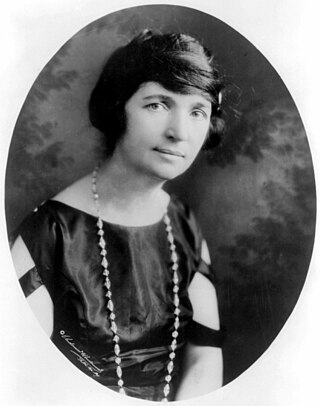
Margaret Higgins Sanger, also known as Margaret Sanger Slee, was an American birth control activist, sex educator, writer, and nurse. Sanger popularized the term "birth control", opened the first birth control clinic in the United States, and established organizations that evolved into the Planned Parenthood Federation of America.

Harlem is a neighborhood in Upper Manhattan, New York City. It is bounded roughly by the Hudson River on the west; the Harlem River and 155th Street on the north; Fifth Avenue on the east; and Central Park North on the south. The greater Harlem area encompasses several other neighborhoods and extends west and north to 155th Street, east to the East River, and south to Martin Luther King Jr. Boulevard, Central Park, and East 96th Street.

The Great Migration, sometimes known as the Great Northward Migration or the Black Migration, was the movement of 6 million African Americans out of the rural Southern United States to the urban Northeast, Midwest, and West between 1910 and 1970. It was caused primarily by the poor economic conditions for African American people, as well as the prevalent racial segregation and discrimination in the Southern states where Jim Crow laws were upheld. In particular, continued lynchings motivated a portion of the migrants, as African Americans searched for social reprieve. The historic change brought by the migration was amplified because the migrants, for the most part, moved to the then-largest cities in the United States at a time when those cities had a central cultural, social, political, and economic influence over the United States. There, African Americans established influential communities of their own. Despite the loss of leaving their homes in the South, and all the barriers faced by the migrants in their new homes, the migration was an act of individual and collective agency, which changed the course of American history, a "declaration of independence" written by their actions.

Arna Wendell Bontemps was an American poet, novelist and librarian, and a noted member of the Harlem Renaissance.
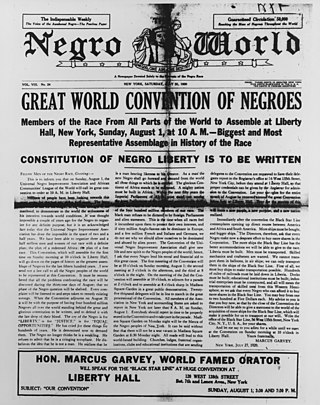
Negro World was the newspaper of the Marcus Garvey's Universal Negro Improvement Association and African Communities League (UNIA). Founded by Garvey and Amy Ashwood Garvey, the newspaper was published weekly in Harlem, New York, and distributed internationally to the UNIA's chapters in more than forty countries. Distributed weekly, at its peak, the Negro World reached a circulation of 200,000.

Hubert Henry Harrison was a West Indian-American writer, orator, educator, critic, race and class conscious political activist, and radical internationalist based in Harlem, New York. He was described by activist A. Philip Randolph as "the father of Harlem radicalism" and by the historian Joel Augustus Rogers as "the foremost Afro-American intellect of his time." John G. Jackson of American Atheists described him as "The Black Socrates".
John Henrik Clarke was an African-American historian, professor, prominent Afrocentrist, and pioneer in the creation of Pan-African and Africana studies and professional institutions in academia starting in the late 1960s.
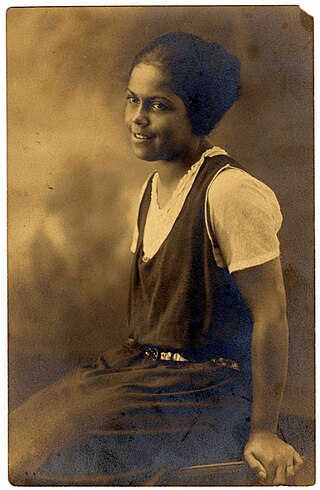
Gwendolyn B. Bennett was an American artist, writer, and journalist who contributed to Opportunity: A Journal of Negro Life, which chronicled cultural advancements during the Harlem Renaissance. Though often overlooked, she herself made considerable accomplishments in art, poetry, and prose. She is perhaps best known for her short story "Wedding Day", which was published in the magazine Fire!! and explores how gender, race, and class dynamics shape an interracial relationship. Bennett was a dedicated and self-preserving woman, respectfully known for being a strong influencer of African-American women rights during the Harlem Renaissance. Throughout her dedication and perseverance, Bennett raised the bar when it came to women's literature and education. One of her contributions to the Harlem Renaissance was her literary acclaimed short novel Poets Evening; it helped the understanding within the African-American communities, resulting in many African Americans coming to terms with identifying and accepting themselves.
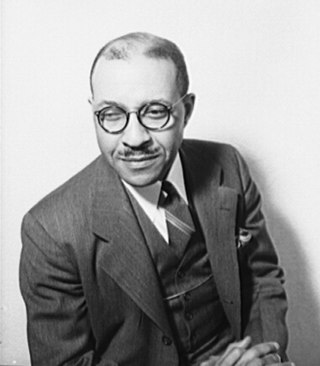
Charles Spurgeon Johnson was an American sociologist and college administrator, the first black president of historically black Fisk University, and a lifelong advocate for racial equality and the advancement of civil rights for African Americans and all ethnic minorities. He preferred to work collaboratively with liberal white groups in the South, quietly as a "sideline activist," to get practical results.

"New Negro" is a term popularized during the Harlem Renaissance implying a more outspoken advocacy of dignity and a refusal to submit quietly to the practices and laws of Jim Crow racial segregation. The term "New Negro" was made popular by Alain LeRoy Locke in his anthology The New Negro.
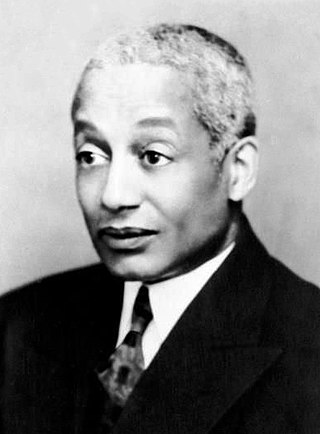
Alain LeRoy Locke was an American writer, philosopher, educator, and patron of the arts. Distinguished in 1907 as the first African-American Rhodes Scholar, Locke became known as the philosophical architect —the acknowledged "Dean"— of the Harlem Renaissance. He is frequently included in listings of influential African Americans. On March 19, 1968, the Rev. Dr. Martin Luther King Jr. proclaimed: "We're going to let our children know that the only philosophers that lived were not Plato and Aristotle, but W. E. B. Du Bois and Alain Locke came through the universe."

The Harlem Renaissance was an intellectual and cultural revival of African-American music, dance, art, fashion, literature, theater, politics and scholarship centered in Harlem, Manhattan, New York City, spanning the 1920s and 1930s. At the time, it was known as the "New Negro Movement", named after The New Negro, a 1925 anthology edited by Alain Locke. The movement also included the new African-American cultural expressions across the urban areas in the Northeast and Midwest United States affected by a renewed militancy in the general struggle for civil rights, combined with the Great Migration of African-American workers fleeing the racist conditions of the Jim Crow Deep South, as Harlem was the final destination of the largest number of those who migrated north.

Eric Derwent Walrond was an Afro-Caribbean Harlem Renaissance writer and journalist. Born in Georgetown, British Guiana, the son of a Barbadian mother and a Guyanese father, Walrond was well-travelled, moving early in life to live in Barbados, and then Panama, New York City, and eventually England. He made a lasting contribution to literature, his most famous book being Tropic Death, published in New York City in 1926 when he was 28; it remains in print today as a classic of its era.
The Negro Project, conceptualized by birth control activist Margaret Sanger and implemented by the Birth Control Federation of America, was an initiative to spread awareness of contraception to lower poverty rates in the South. Once the project received funding, it was taken out of Sanger's hands and taken over by the BFCA, who pushed funding into preexisting clinics. Dr. Clarence Gamble, physician and heir to the Proctor and Gamble soap company fortune, was an influential figure on the project, supervising and partially funding the endeavor. While the original plan for the Negro Project included educational outreach into black communities as well as the establishment of black-operated clinical resources, the project that was implemented deviated from this original design and was ultimately unsuccessful.

The birth control movement in the United States was a social reform campaign beginning in 1914 that aimed to increase the availability of contraception in the U.S. through education and legalization. The movement began in 1914 when a group of political radicals in New York City, led by Emma Goldman, Mary Dennett, and Margaret Sanger, became concerned about the hardships that childbirth and self-induced abortions brought to low-income women. Since contraception was considered to be obscene at the time, the activists targeted the Comstock laws, which prohibited distribution of any "obscene, lewd, and/or lascivious" materials through the mail. Hoping to provoke a favorable legal decision, Sanger deliberately broke the law by distributing The Woman Rebel, a newsletter containing a discussion of contraception. In 1916, Sanger opened the first birth control clinic in the United States, but the clinic was immediately shut down by police, and Sanger was sentenced to 30 days in jail.
Opportunity: A Journal of Negro Life was an academic journal published by the National Urban League (NUL). The journal acted as a sociological forum for the emerging topic of African-American studies and was known for fostering the literary culture during the Harlem Renaissance. It was published monthly from 1923 to 1942 and then quarterly through 1949.

Founded in the 17th century as a Dutch outpost, Harlem developed into a farming village, a revolutionary battlefield, a resort town, a commuter town, a center of African-American culture, a ghetto, and a gentrified neighborhood.

Clarissa Scott Delany, neeClarissa Mae Scott (1901–1927) was an African-American poet, essayist, educator and social worker associated with the Harlem Renaissance.

In the United States, black genocide is the notion that the mistreatment of African Americans by both the United States government and white Americans, both in the past and the present, amounts to genocide. The decades of lynchings and long-term racial discrimination were first formally described as genocide by a now-defunct organization, the Civil Rights Congress, in a petition which it submitted to the United Nations in 1951. In the 1960s, Malcolm X accused the US government of engaging in a genocide against black people, citing long-term injustice, cruelty, and violence against blacks by whites.
Milton Arthur Galamison was a Presbyterian minister who served in Brooklyn, New York. As a community activist, he championed integration and education reform in the New York City public school system, and organized two school boycotts.















